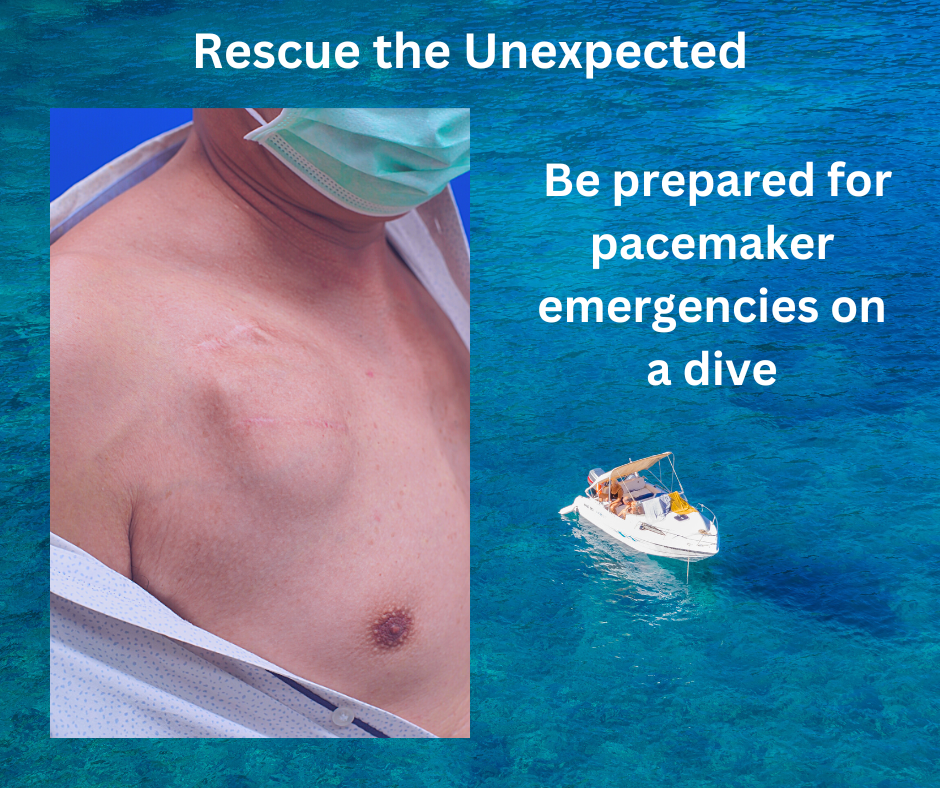

As a rescue diver, you must be mindful that individuals with pacemakers do and will dive. Deciding whether or not someone can dive safely with a pacemaker requires medical determination and individuals inquiring about it should be directed back to their cardiologist. Despite the odds that you may never come across a rescue situation involving a pacemaker patient, knowing what to do if you do can save that individual’s life.
The question of whether or not an individual with an implanted pacemaker should be diving is not easily answered. There are many factors that need to be considered. The first thing that should be determined is whether the individual is otherwise healthy enough for the strenuous exercise that may be associated with diving? This can only be answered by the diver’s cardiologist. The diver should consult with his cardiologist before attempting any diving. It is likely the cardiologist will want a stress test to determine the diver’s ability to handle the stress of diving.
A second consideration is why is there a pacemaker implanted in the individual in the first place? The most likely answer is the individual has experienced a cardiac event in the past that resulted in ischemia or the death of cardiac muscle. If this is the case, the individual should be discouraged from diving. Pacemakers are also implanted when there are conduction problems within the heart. In these cases the pacemaker is installed to help regulate the electrical impulses that trigger cardiac contractions. In these cases the individual may be able to dive; however, consultation with a cardiologist is a must.
The final consideration is whether the medical device is rated to operate at the elevated pressures experienced during diving? Pacemakers must be able to withstand the increased pressure experienced by the diver and the cycling between low and high pressures experienced on a dive. A pacemaker is inserted just below the skin and is subject to the same pressures as the diver. There has been some research done into the impact of pressure on different pacemakers. Some operate fine down to 5 ATA (about 130 feet). Others have problems at more shallow depths. In some cases the pacemaker has suffered some serious deformity when subjected to pressures at 130 feet. The diver needs to be aware of the type of medical device implanted and its pressure characteristics.
Unfortunately, not all individuals will seek medical advice before diving, and even in cases where they have, things can go wrong. The likely outcome of a pacemaker failure is cardiac arrest. The primary rescue technique for cardiac arrest is CPR. Unfortunately, CPR requires a solid surface to push against and cannot be accomplished while in the water. Providing resuscitation (rescue breathing) while in the water is possible. Rescue breaths can be administered via either mouth to mouth or mouth to snorkel. The issue with in water resuscitation lies in the fact that in a cardiac arrest situation the lack of circulation renders rescue breathing as relatively useless. Serious and permanent brain damage begins after about four minutes. Attempting ineffective rescue breaths while in the water will likely only delay the time it would take to get the victim in a boat or back to shore where cardiac compressions can be attempted. The dive rescuer must take into account the time it will take to get the victim to a stable location before beginning in water resuscitation.
The thing to keep in mind when attempting a rescue of a diver who has experienced a dive emergency related to his implanted pacemaker is this individual requires medical intervention that cannot be accomplished in the water. The main objective in such a rescue situation is to get the individual out of the water onto a stable platform. Of course not all dive emergencies will involve cardiac arrest. In the event of a non-cardiac dive emergency the individual who has an implanted pacemaker should be handled in the same manner as a non-pacemaker diver. The only difference you need to keep in mind is the additional stress placed on the dive can lead to cardiac problems. What is not a cardiac emergency can rapidly become one. One consideration when involved in a potential cardiac rescue is supplemental oxygen. Cardiac arrest is the result of damage to the heart muscle which usually occurs due to a lack of sufficient oxygen being delivered to the cardiac muscle. Supplying supplemental oxygen can go a long way in preventing a non-cardiac dive emergency from becoming a cardiac dive emergency.
You are not going to restore functionality to a failed pacemaker. Treat any rescue event involving an individual with an implanted pacemaker as a cardiac or potential cardiac event. Get the individual to a stable location where CPR can be performed if needed and administer supplemental oxygen. Individuals with implanted pacemakers will and do dive. The rescue diver needs to be prepared for any cardiac event that may occur during diving and keep in mind that in situations in which the victim of a dive emergency has a pacemaker the most insignificant event can rapidly escalate to a cardiac emergency.
Whether you are a beginner considering taking up diving, an individual seeking to become a professional rescue diver, or a seasoned rescue diver seeking to increase your skills, Malibu Divers is committed to diver education, safety, and enjoyment. Contact us to learn more.



Share:
Exploring the World of Drysuit Diving: What You Need to Know
Exploring the Depths: A Guide to Underwater Imaging